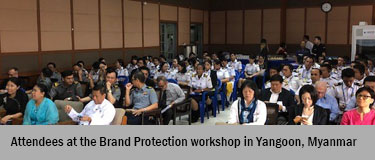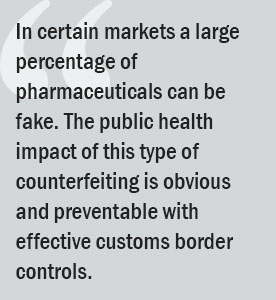INTA Holds First Training in Myanmar Since Passage of Trademark Law
Published: September 1, 2019
INTA organized a training workshop on July 23, along with the Pharmaceutical Security Institute, Myanmar Customs, and the U.S. Patent and Trademark Office in Yangoon, Myanmar, which focused on brand protection and intellectual property (IP) border enforcement for Myanmar Customs. During the event, customs officers heard from brand owners and government officials about the latest legislative and regulatory trends in cross-border IP enforcement and how to identify counterfeit products. This was the first training of its kind since the country passed its trademark law earlier this year.

INTA Chief Representative Asia-Pacific Seth Hays gave an overview of the Association’s work to improve global trademark anticounterfeiting efforts. Along these lines, Mr. Hays highlighted INTA’s recently released Gen Z Insights: Brands and Counterfeit Products study, which provides insights into how young consumers view counterfeit goods, as well as Gen Z’s relationship with brands. He noted that the research represents a powerful example of the opportunity governments have to communicate with young consumers and raise their awareness of the danger of counterfeit goods.
Deputy Director General of Myanmar Customs U Aung SunTun noted that customs officials take the lead in preventing the spread of counterfeits in Myanmar and are on the frontlines fighting against the proliferation of fake goods. He welcomed cooperation with the IP industry to improve the protection of IP rights and to foster a better investment environment in the country.
Ministry of Education, Intellectual Property Department, Deputy Director General Moe Moe Thwe remarked that the country earlier this year passed a set of IP laws, including the first trademark law in the country’s history. Ms. Thwe noted that the new law will form the legal basis for a national innovation system.  She explained that important work in Myanmar is underway to open the Intellectual Property Agency by the end of the year, with the intention to be fully operational by the middle of next year. The agency will use systems from the World Intellectual Property Organization to automate and digitize its services. Among current projects is the translation of the Nice Classification (11th edition) into Burmese.
She explained that important work in Myanmar is underway to open the Intellectual Property Agency by the end of the year, with the intention to be fully operational by the middle of next year. The agency will use systems from the World Intellectual Property Organization to automate and digitize its services. Among current projects is the translation of the Nice Classification (11th edition) into Burmese.
Ramesh Raj (Pharmaceutical Security Institute, Myanmar) shared information on how his organization provides direct links with leading members of the pharmaceutical industry globally. Mr. Raj pointed out that in certain markets a large percentage of pharmaceuticals can be fake. The public health impact of this type of counterfeiting is obvious and preventable with effective customs border controls.
Stephen Jones (Syngenta, Myanmar) noted that 38 percent of Myanmar’s GDP comes from agriculture, and the use of fake agricultural chemicals can lead to stronger resistant pests. Additionally, for many farmers, using goods that are ineffective can severely threaten their livelihood.
Zaw Moe Khine (Pacific AA group, Myanmar) discussed how fake auto parts are distributed in Myanmar, emphasizing that online sites are a major channel for the sale of these goods. He provided the officers with tips to tell whether a car part may be fake, such as determining the country of origin and examining markings on the box containing the part.
Alan Liu (Johnson & Johnson, Myanmar) noted the dangers of counterfeited Johnson & Johnson products, particularly those used on children, such as baby shampoo. He pointed out that in neighboring countries such as Bangladesh, the number of counterfeits on the market can be extremely high. Links between the Bangladesh market and the Myanmar market for counterfeits should be further explored, he said, adding that customs plays a role in preventing the spread of counterfeits across these borders.
Join us at the 2019 Asia Conference: Brands in Changing Times
Innovate. Protect. Enforce. Grow.
October 17-18, Kuala Lumpur, Malaysia
Don’t miss this dynamic event, where we explore key issues affecting brand owners doing business in the region today. Sessions focusing on anticounterfeiting include The Role of Consumers in the Fight Against Counterfeits and Fighting Counterfeits: A Community Approach.
Get more details on programming, and register here.
INTA’s Asia-Pacific Representative Office, based in Singapore, represents the Association’s 789 members across the region. Working in collaboration with staff at INTA’s headquarters in New York City, the Asia-Pacific Representative Office leads the Association’s policy, membership, marketing, and communications initiatives throughout this region. To learn more about INTA’s activities in the Asia-Pacific, please contact INTA Chief Representative Officer Seth Hays at [email protected].
Although every effort has been made to verify the accuracy of items in the INTA Bulletin, readers are urged to check independently on matters of specific concern or interest.
© 2019 International Trademark Association
This website uses cookies so that we can provide you with the best user experience possible. Cookie information is stored in your browser and performs functions such as recognising you when you return to our website and helping our team to understand which sections of the website you find most interesting and useful.
To find out more please see our Cookies Policy and Privacy Policy.
These cookies are used to identify a user’s browser as the visitor goes from page to page on the Site. These are session cookies, which means that the cookie is deleted when you leave the Site. It is an integral piece of the Site software and used to let the server know which users are on the Site at any given time and make certain parts of the Site easier to use.
|
|
If you disable this cookie, we will not be able to save your preferences. This means that every time you visit this website you will need to enable or disable cookies again.
These cookies are used to collect information about how visitors use our Site. The cookies collect information in anonymous form, including the numbers of visitors to the Site, where visitors have come to the Site from, the pages they visited and how they have interacted with tools on the Site like search and embedded media players. We use the information to compile statistical reports of our users’ browsing patterns so that we can improve the Site.
|
|
Please enable Functionality Cookies first so that we can save your preferences!
These cookies are used to deliver advertising relevant to the interests of visitors to our Site. They are persistent, which means they will remain on your device after you leave the Site.
- Facebook (Ad Pixel)
- Google (Ad Pixel)
- LinkedIn (Ad Pixel)
- Quattro Anonymous
Please enable Functionality Cookies first so that we can save your preferences!
